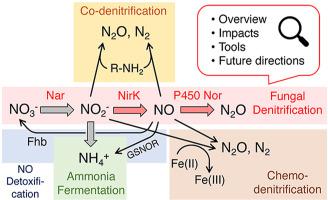Soil Biology and Biochemistry ( IF 9.7 ) Pub Date : 2021-04-12 , DOI: 10.1016/j.soilbio.2021.108250 Nouf Aldossari , Satoshi Ishii

|
Fungi play a key role in the nitrogen cycle. Diverse fungi are known to reduce nitrate or nitrite to gaseous nitrogen oxides such as nitric oxide, nitrous oxide (N2O), and dinitrogen via denitrification or co-denitrification (microbially mediated nitrosation), and to ammonium via ammonia fermentation (fungal dissimilatory nitrate reduction to ammonium). These processes could significantly contribute to the emission of N2O from soils and the removal of nitrogen from nitrate and nitrite-contaminated environments. However, fungal N2O production may not be necessarily related to their denitrification activity sensu stricto (i.e., reduction of nitrate or nitrite to gaseous N oxides for respiration): N2O can be produced by partially abiotic processes. Therefore, fungi that can reduce nitrate or nitrite to N2O should not be called denitrifying fungi instantaneously. Experiments should be carefully conducted to better discriminate fungal denitrification, co-denitrification, and chemo-denitrification. Various analytical tools have been developed and applied to clarify fungal denitrification and other nitrate/nitrite reduction processes, including the substrate-induced respiration-inhibition method, stable isotope analyses, and culture-dependent and -independent molecular and genomic approaches. In this mini-review, we overview fungal denitrification and other nitrate/nitrite reduction processes, discuss their environmental impacts, summarize recent advancements in the methods to study fungal denitrification, and provide insights on future research opportunities.
中文翻译:

再谈真菌脱硝-最新进展和未来机会
真菌在氮循环中起关键作用。已知多种真菌通过反硝化或共反硝化(微生物介导的亚硝化)将硝酸盐或亚硝酸盐还原为气态氮氧化物,例如一氧化氮,一氧化二氮(N 2 O)和二氮,并通过氨发酵(真菌异化硝酸盐)还原为铵。还原成铵)。这些过程可以显着促进土壤中N 2 O的排放以及氮氧化物和亚硝酸盐污染环境中氮的去除。但是,真菌N 2 O的产生可能不一定与其感觉的反硝化活性有关(即,将硝酸盐或亚硝酸盐还原为气态N氧化物以进行呼吸):N 2O可以通过部分非生物过程产生。因此,可以将硝酸盐或亚硝酸盐还原为N 2的真菌O不应立即称为反硝化真菌。应仔细进行实验,以更好地区分真菌的反硝化作用,共反硝化作用和化学反硝化作用。已经开发出各种分析工具来阐明真菌的反硝化作用和其他硝酸盐/亚硝酸盐的还原过程,包括底物诱导的呼吸抑制方法,稳定的同位素分析以及依赖于培养物和不依赖于培养物的分子和基因组方法。在此小型审查中,我们概述了真菌的反硝化作用和其他硝酸盐/亚硝酸盐的还原过程,讨论了它们对环境的影响,总结了研究真菌反硝化方法的最新进展,并提供了对未来研究机会的见识。


























 京公网安备 11010802027423号
京公网安备 11010802027423号